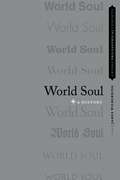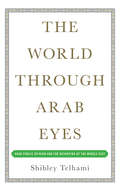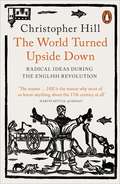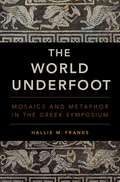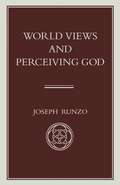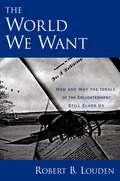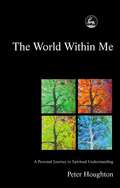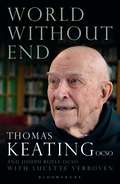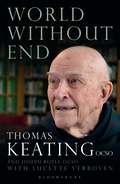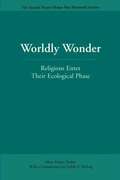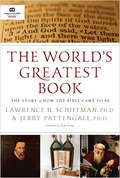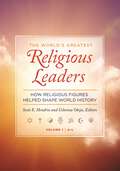- Table View
- List View
World Soul: A History (Oxford Philosophical Concepts)
by James WilberdingMany philosophers and scientists over the course of history have held that the world is alive. It has a soul, which governs it and binds it together. This suggestion, once so wide-spread, may strike many of us today as strange and antiquated--in fact, there are few other concepts that, on their face, so capture the sheer distance between us and our philosophical inheritance. But the idea of a world soul has held so strong a grip upon philosophers' imaginations for over 2,000 years, that it continues to underpin and even structure how we conceive of time and space. The concept of the world soul is difficult to understand in large part because over the course of history it has been invoked to very different ends and within the frameworks of very different ontologies and philosophical systems, with varying concepts of the world soul emerging as a result. This volume brings together eleven chapters by leading philosophers in their respective fields that collectively explore the various ways in which this concept has been understood and employed, covering the following philosophical areas: Platonism, Stoicism, Medieval, Indian or Vedântic, Kabbalah, Renaissance, Early Modern, German Romanticism, German Idealism, American Transcendentalism, and contemporary quantum mechanics and panpsychism theories. In addition, short reflections illuminate the impact the concept of the world soul has had on a small selection of areas outside of philosophy, such as harmony, the biological concept of spontaneous generation, Henry Purcell, psychoanalysis, and Gaia theories.
World Soul: A History (Oxford Philosophical Concepts)
Many philosophers and scientists over the course of history have held that the world is alive. It has a soul, which governs it and binds it together. This suggestion, once so wide-spread, may strike many of us today as strange and antiquated--in fact, there are few other concepts that, on their face, so capture the sheer distance between us and our philosophical inheritance. But the idea of a world soul has held so strong a grip upon philosophers' imaginations for over 2,000 years, that it continues to underpin and even structure how we conceive of time and space. The concept of the world soul is difficult to understand in large part because over the course of history it has been invoked to very different ends and within the frameworks of very different ontologies and philosophical systems, with varying concepts of the world soul emerging as a result. This volume brings together eleven chapters by leading philosophers in their respective fields that collectively explore the various ways in which this concept has been understood and employed, covering the following philosophical areas: Platonism, Stoicism, Medieval, Indian or Vedântic, Kabbalah, Renaissance, Early Modern, German Romanticism, German Idealism, American Transcendentalism, and contemporary quantum mechanics and panpsychism theories. In addition, short reflections illuminate the impact the concept of the world soul has had on a small selection of areas outside of philosophy, such as harmony, the biological concept of spontaneous generation, Henry Purcell, psychoanalysis, and Gaia theories.
The World Through Arab Eyes: Arab Public Opinion and the Reshaping of the Middle East
by Shibley TelhamiThe uprisings that transformed the Middle East beginning in 2011 have left experts scrambling to understand where the region is likely to go in years to come. But missing from most of the analysis is a longer view of the evolution of Arab Public opinion and identity and how this is likely to influence this fast-changing region. In The World Through Arab Eyes, Shibley Telhami shows how the roots of these rebellions stretch back decades and explains how they will continue to affect the stability of the Middle East in the years to come. Telhami draws on a decade's worth of polling data and analysis to provide a comprehensive look at this evolution of Arab identity and opinion. The demand for dignity, which was foremost in the chants of millions of Arab demonstrators, went far beyond being a struggle for "food” and individual rights. Telhami identifies the key prisms through which Arabs view issues ranging from democracy and religion to foreign actors, including the United States, European and Asian countries, Iran, Turkey, and, centrally, Israel. These prisms provide a key to interpreting the past, comprehending the seismic changes in Arab politics today, and engaging with the region in the future.
The World Turned Upside Down: Radical Ideas During the English Revolution (Peregrine Bks.)
by Christopher Hill'His finest work and one that was both symptom and engine of the concept of "history from below" ... Here Levellers, Diggers, Ranters, Muggletonians, the early Quakers and others taking advantage of the collapse of censorship to bid for new kinds of freedom were given centre stage ... Hill lives on' Times Higher EducationIn 'The World Turned Upside Down' Christopher Hill studies the beliefs of such radical groups as the Diggers, the Ranters, the Levellers and others, and the social and emotional impulses that gave rise to them. The relations between rich and poor classes, the part played by wandering 'masterless' men, the outbursts of sexual freedom, the great imaginative creations of Milton and Bunyan - these and many other elements build up into a marvellously detailed and coherent portrait of this strange, sudden effusion of revolutionary beliefs.'Established the concept of an "English Revolution" every bit as significant and potentially as radical as its French and Russian equivalents' Daily Telegraph'Brilliant ... marvellous erudition and sympathy' David Caute, New Statesman'This book will outlive our time and will stand as a notable monument to the man, the committed radical scholar, and one of the finest historians of the age' The Times Literary Supplement'The dean and paragon of English historians' E.P. Thompson
The World Underfoot: Mosaics and Metaphor in the Greek Symposium
by Hallie M. FranksIn the Greek Classical period, the symposium--the social gathering at which male citizens gathered to drink wine and engage in conversation--was held in a room called the andron. From couches set up around the perimeter, symposiasts looked inward to the room's center, which often was decorated with a pebble mosaic floor. These mosaics provided visual treats for the guests, presenting them with images of mythological scenes, exotic flora, dangerous beasts, hunting parties, or the spectre of Dionysos: the god of wine, riding in his chariot or on the back of a panther. In The World Underfoot, Hallie M. Franks takes as her subject these mosaics and the context of their viewing. Relying on discourses in the sociology and anthropology of space, she presents an innovative new interpretation of the mosaic imagery as an active contributor to the symposium as a metaphorical experience. Franks argues that the images on mosaic floors, combined with the ritualized circling of the wine cup and the physiological reaction to wine during the symposium, would have called to mind other images, spaces, or experiences, and in doing so, prompted drinkers to reimagine the symposium as another kind of event--a nautical voyage, a journey to a foreign land, the circling heavens or a choral dance, or the luxury of an abundant past. Such spatial metaphors helped to forge the intimate bonds of friendship that are the ideal result of the symposium and that make up the political and social fabric of the Greek polis.
The World Underfoot: Mosaics and Metaphor in the Greek Symposium
by Hallie M. FranksIn the Greek Classical period, the symposium--the social gathering at which male citizens gathered to drink wine and engage in conversation--was held in a room called the andron. From couches set up around the perimeter, symposiasts looked inward to the room's center, which often was decorated with a pebble mosaic floor. These mosaics provided visual treats for the guests, presenting them with images of mythological scenes, exotic flora, dangerous beasts, hunting parties, or the spectre of Dionysos: the god of wine, riding in his chariot or on the back of a panther. In The World Underfoot, Hallie M. Franks takes as her subject these mosaics and the context of their viewing. Relying on discourses in the sociology and anthropology of space, she presents an innovative new interpretation of the mosaic imagery as an active contributor to the symposium as a metaphorical experience. Franks argues that the images on mosaic floors, combined with the ritualized circling of the wine cup and the physiological reaction to wine during the symposium, would have called to mind other images, spaces, or experiences, and in doing so, prompted drinkers to reimagine the symposium as another kind of event--a nautical voyage, a journey to a foreign land, the circling heavens or a choral dance, or the luxury of an abundant past. Such spatial metaphors helped to forge the intimate bonds of friendship that are the ideal result of the symposium and that make up the political and social fabric of the Greek polis.
World Upside Down: Reading Acts in the Graeco-Roman Age
by C. Kavin RoweFor almost 300 years, the dominant trend in New Testament interpretation has been to read the Acts of the Apostles as a document that argues for the political possibility of harmonious co-existence between 'Rome' and the early Christian movement. Kavin Rowe argues that the time is long overdue for a sophisticated, critically constructive reappraisal. "A brilliant piece of work by a young scholar of considerable promise." --First Things "This well-written, well-argued book is a must read for New Testament scholars." -- Review of Biblical Literature "This sophisticated argument offers a comprehensive vision of Acts and deserves a wide readership." -- Religious Studies Review "There is so much happening in these pages that a slow and careful read will provoke sustained thoughts on a variety of subjects of ecclesial interest ranging from Christianity and culture to issues of tolerance and political theology." -- Themelios
World Upside Down: Reading Acts in the Graeco-Roman Age
by C. Kavin RoweFor almost 300 years, the dominant trend in New Testament interpretation has been to read the Acts of the Apostles as a document that argues for the political possibility of harmonious co-existence between 'Rome' and the early Christian movement. Kavin Rowe argues that the time is long overdue for a sophisticated, critically constructive reappraisal. "A brilliant piece of work by a young scholar of considerable promise." --First Things "This well-written, well-argued book is a must read for New Testament scholars." -- Review of Biblical Literature "This sophisticated argument offers a comprehensive vision of Acts and deserves a wide readership." -- Religious Studies Review "There is so much happening in these pages that a slow and careful read will provoke sustained thoughts on a variety of subjects of ecclesial interest ranging from Christianity and culture to issues of tolerance and political theology." -- Themelios
World Views and the Problem of Synthesis: The Yellow Book of “Einstein Meets Magritte” (Einstein Meets Magritte: An Interdisciplinary Reflection on Science, Nature, Art, Human Action and Society #4)
by JanVeken HubertBelle DiederikAertsThis book considers philosophy to be more than mere reflection. Through philosophy, humankind can give meaning to the world. In part, this book re-evaluates the philosophy of Leo Apostel, who dedicated his life to the investigation of the use of philosophy in everyday life. But it is also a presentation of international research carried out along the lines of the worldviews project. The contributions address not only professional philosophers, but also students, teachers, academics and everyone interested in the relationship between philosophy and the world.
The World We Want: How and Why the Ideals of the Enlightenment Still Elude Us
by Robert B. LoudenThe World We Want compares the future world that Enlightenment intellectuals had hoped for with our own world at present. In what respects do the two worlds differ, and why are they so different? To what extent is and isn't our world the world they wanted, and to what extent do we today still want their world? Unlike previous philosophical critiques and defenses of the Enlightenment, the present study focuses extensively on the relevant historical and empirical record first, by examining carefully what kind of future Enlightenment intellectuals actually hoped for; second, by tracking the different legacies of their central ideals over the past two centuries. But in addition to documenting the significant gap that still exists between Enlightenment ideals and current realities, the author also attempts to show why the ideals of the Enlightenment still elude us. What does our own experience tell us about the appropriateness of these ideals? Which Enlightenment ideals do not fit with human nature? Why is meaningful support for these ideals, particularly within the US, so weak at present? Which of the means that Enlightenment intellectuals advocated for realizing their ideals are inefficacious? Which of their ideals have devolved into distorted versions of themselves when attempts have been made to realize them? How and why, after more than two centuries, have we still failed to realize the most significant Enlightenment ideals? In short, what is dead and what is living in these ideals?
The World We Want: How and Why the Ideals of the Enlightenment Still Elude Us
by Robert B. LoudenThe World We Want compares the future world that Enlightenment intellectuals had hoped for with our own world at present. In what respects do the two worlds differ, and why are they so different? To what extent is and isn't our world the world they wanted, and to what extent do we today still want their world? Unlike previous philosophical critiques and defenses of the Enlightenment, the present study focuses extensively on the relevant historical and empirical record first, by examining carefully what kind of future Enlightenment intellectuals actually hoped for; second, by tracking the different legacies of their central ideals over the past two centuries. But in addition to documenting the significant gap that still exists between Enlightenment ideals and current realities, the author also attempts to show why the ideals of the Enlightenment still elude us. What does our own experience tell us about the appropriateness of these ideals? Which Enlightenment ideals do not fit with human nature? Why is meaningful support for these ideals, particularly within the US, so weak at present? Which of the means that Enlightenment intellectuals advocated for realizing their ideals are inefficacious? Which of their ideals have devolved into distorted versions of themselves when attempts have been made to realize them? How and why, after more than two centuries, have we still failed to realize the most significant Enlightenment ideals? In short, what is dead and what is living in these ideals?
The World Within Me: A Personal Journey to Spiritual Understanding (PDF)
by Peter HoughtonIn this thoughtful and profound account Peter Houghton charts his personal quest for the spirit. His extraordinary story is written during the time in which he had received a diagnosis of terminal heart disease and reflects on the ways in which being about to die developed his ideas about spirituality and humanity. He describes the development of his search for understanding and meaning in life from an initial sense of spiritual awareness through stages of uncertainty and despair to the ultimate formation of a unifying personal philosophy. Writing in an accessible and personalised style he discusses important questions about ethics and meaning in life, the problem of evil, and organised and personal religion, considering the ideas of Christianity and other faiths.
World Without End
by Father Thomas Keating Lucette Verboven Abbot Joseph BoyleIn these conversations with film maker and writer Lucette Verboven, Thomas Keating OCSO – bestselling author, Trappist monk and founder of the Centering Prayer movement – looks back on his long life and spiritual development. Following on from his previous books Invitation to Love, Open Mind, Open Heart and The Mystery of Christ, Father Keating now turns his attention to the themes of awakening, the nature of true happiness and the character and purpose of death. World Without End also contains an interview with Abbot Joseph Boyle OCSO, who presides over the monastery where Father Keating is resident, high in the Rocky Mountains in Snowmass, Colorado. Verboven's insightful questions probe into the depths of Father Keating's spirituality, discussing identity, transformation, silence, nature and the cosmos – themes universal and applicable to all those searching for a deeper and more meaningful life.
World Without End
by Thomas Keating Lucette Verboven Joseph BoyleIn these conversations with film maker and writer Lucette Verboven, Thomas Keating OCSO – bestselling author, Trappist monk and founder of the Centering Prayer movement – looks back on his long life and spiritual development. Following on from his previous books Invitation to Love, Open Mind, Open Heart and The Mystery of Christ, Father Keating now turns his attention to the themes of awakening, the nature of true happiness and the character and purpose of death. World Without End also contains an interview with Abbot Joseph Boyle OCSO, who presides over the monastery where Father Keating is resident, high in the Rocky Mountains in Snowmass, Colorado. Verboven's insightful questions probe into the depths of Father Keating's spirituality, discussing identity, transformation, silence, nature and the cosmos – themes universal and applicable to all those searching for a deeper and more meaningful life.
A World Without Islam
by Graham E. FullerWhat if Islam never existed? To some, it's a comforting thought: no clash of civilizations, no holy wars, no terrorists. But what if that weren't the case at all? In A World Without Islam, Graham E. Fuller guides us along an illuminating journey through history, geopolitics, and religion to investigate whether or not Islam is indeed the cause of some of today's most emotional and important international crises. Fuller takes us from the birth of Islam to the fall of Rome to the rise and collapse of the Ottoman Empire. He examines and analyzes the roots of terrorism, the conflict in Israel, and the role of Islam in supporting and energizing the anti-imperial struggle. Provocatively, he finds that contrary to the claims of many politicians, thinkers, theologians, and soldiers, a world without Islam might not look vastly different from what we know today. Filled with fascinating details and counterintuitive conclusions, A World Without Islam is certain to inspire debate and reshape the way we think about Islam's relationship with the West.
Worldly Politics and Divine Institutions: Contemporary Entanglements of Faith and Government
by Nahshon PerezThe institutional entanglement of religion and government takes many forms, including direct governmental funding of religious associations, legal recognition, and governmental endorsement of religious symbols in public spaces. The entanglement of church and state remains contentious in many democratic countries today. In fact, in Europe and North America, there are a growing number of instances of governments becoming entwined with religious matters. Worldly Politics and Divine Institutions explores the entanglement of religion and government in a comparative analysis of four cases within democratic countries: the British Jewish Free School (JFS) case, in which the U.K. Supreme Court forced a government-funded faith school to change its admission policies; The European Court of Human Rights decision in Martinez, in which the Catholic church kept its right to dismiss religion teachers within the Spanish public school system; The Lautsi case, in which the Italian government successfully defended its policy of mandating a crucifix in all public school classrooms - at the European Court of Human Rights; and the case of the Bladensburg World War I Memorial (often called the Peace Cross) in Maryland, in which the U.S. Supreme Court ruled that the cross's public placement and maintenance funding does not violate the non-establishment clause of the First Amendment. Perez describes how these cases create complex, hybrid religious-statist institutions and outlines a novel framework for understanding these cases.
Worldly Politics and Divine Institutions: Contemporary Entanglements of Faith and Government
by Nahshon PerezThe institutional entanglement of religion and government takes many forms, including direct governmental funding of religious associations, legal recognition, and governmental endorsement of religious symbols in public spaces. The entanglement of church and state remains contentious in many democratic countries today. In fact, in Europe and North America, there are a growing number of instances of governments becoming entwined with religious matters. Worldly Politics and Divine Institutions explores the entanglement of religion and government in a comparative analysis of four cases within democratic countries: the British Jewish Free School (JFS) case, in which the U.K. Supreme Court forced a government-funded faith school to change its admission policies; The European Court of Human Rights decision in Martinez, in which the Catholic church kept its right to dismiss religion teachers within the Spanish public school system; The Lautsi case, in which the Italian government successfully defended its policy of mandating a crucifix in all public school classrooms - at the European Court of Human Rights; and the case of the Bladensburg World War I Memorial (often called the Peace Cross) in Maryland, in which the U.S. Supreme Court ruled that the cross's public placement and maintenance funding does not violate the non-establishment clause of the First Amendment. Perez describes how these cases create complex, hybrid religious-statist institutions and outlines a novel framework for understanding these cases.
Worldly Wonder: Religions Enter Their Ecological Phase (Master Hsüan Hua Memorial Lecture Ser. (PDF))
by Mary Evelyn Tucker Judith A. BerlingHistory illustrates the power of religion to bring about change. Mary Evelyn Tucker describes how world religions have begun to move from a focus on God-human and human-human relations to encompass human-earth relations. She argues that, in light of the environmental crisis, religion should move from isolated orthodoxy to interrelated dialogue and use its authority for liberation rather than oppression.
The World's Christians: Who they are, Where they are, and How they got there
by Douglas JacobsenWritten by an award-winning author, this well-organized and comprehensive introduction to global Christianity illuminates the many ways the world's Christians live their faith today. Covers the entire globe: Africa, Asia, and Latin America as well as Europe, North America, and the Pacific Provides impartial, in-depth descriptions of the world's four major Christian traditions: Orthodox, Catholic, Protestant, and Pentecostal/Charismatic Utilizes the best available sources to produce an up-to-date profile of demographic trends in the Christian population Blends history, sociology, anthropology, and theology to create a rich, multi-layered analysis of the world Christian movement Features clear maps and 4-color illustrations throughout the volume
The World's Christians: Who they are, Where they are, and How they got there
by Douglas JacobsenWritten by an award-winning author, this well-organized and comprehensive introduction to global Christianity illuminates the many ways the world's Christians live their faith today. Covers the entire globe: Africa, Asia, and Latin America as well as Europe, North America, and the Pacific Provides impartial, in-depth descriptions of the world's four major Christian traditions: Orthodox, Catholic, Protestant, and Pentecostal/Charismatic Utilizes the best available sources to produce an up-to-date profile of demographic trends in the Christian population Blends history, sociology, anthropology, and theology to create a rich, multi-layered analysis of the world Christian movement Features clear maps and 4-color illustrations throughout the volume
The World's Christians: Who They Are, Where They Are, and How They Got There
by Douglas JacobsenThis accessible textbook describes Christianity, the world’s largest religion, in all of its historical and contemporary diversity. No other publication includes so much information or presents it so clearly and winsomely. This volume employs a “religious studies” approach that is neutral in tone yet accommodates the lived experiences of Christians in different traditions and from all regions of the globe. The World’s Christians is a perfect textbook for either public university classrooms or liberal arts campuses. Divided into three parts, the text first describes the world’s four largest Christian traditions (Eastern Orthodox, Roman Catholic, Protestant, and Pentecostal) which together account for roughly 98 percent of all Christians worldwide. A second section focuses on Christian history, explaining the movement’s developing ideas and practices and examining Christianity’s engagement with people and cultures around the world. The third and longest portion of the text details the distinctive experiences, contemporary challenges, and demographics of Christians in nine geographic regions, including the Middle East, Sub-Saharan Africa, Latin America, Eastern and Western Europe, South Asia, North America, East Asia, and Oceania. The second edition of this popular text has been thoroughly rewritten to take recent developments into account, and each chapter now includes two primary source readings, highlighting the diversity of voices that exist within the world Christian movement. Like the first edition, the revised text is enhanced with easily understandable maps, charts, tables and illustrative photographs. In summary, this new and improved second edition of The World’s Christians is: <div style="margin
The World's Christians: Who They Are, Where They Are, and How They Got There
by Douglas JacobsenThis accessible textbook describes Christianity, the world’s largest religion, in all of its historical and contemporary diversity. No other publication includes so much information or presents it so clearly and winsomely. This volume employs a “religious studies” approach that is neutral in tone yet accommodates the lived experiences of Christians in different traditions and from all regions of the globe. The World’s Christians is a perfect textbook for either public university classrooms or liberal arts campuses. Divided into three parts, the text first describes the world’s four largest Christian traditions (Eastern Orthodox, Roman Catholic, Protestant, and Pentecostal) which together account for roughly 98 percent of all Christians worldwide. A second section focuses on Christian history, explaining the movement’s developing ideas and practices and examining Christianity’s engagement with people and cultures around the world. The third and longest portion of the text details the distinctive experiences, contemporary challenges, and demographics of Christians in nine geographic regions, including the Middle East, Sub-Saharan Africa, Latin America, Eastern and Western Europe, South Asia, North America, East Asia, and Oceania. The second edition of this popular text has been thoroughly rewritten to take recent developments into account, and each chapter now includes two primary source readings, highlighting the diversity of voices that exist within the world Christian movement. Like the first edition, the revised text is enhanced with easily understandable maps, charts, tables and illustrative photographs. In summary, this new and improved second edition of The World’s Christians is: <div style="margin
The World's Greatest Book: The Story of How the Bible Came to Be
by Lawrence H. Schiffman Jerry Pattengale Museum of the Bible BooksWelcome to the fascinating story of how we got the world's greatest book -- the Bible.It is a captivating story that includes a little bit of everything: adventure and violence, mystery and bravery, and dumb luck or divine intervention -- depending on your point of view.How in the world did we get this book that some people swear by and other people swear at? You don't have to be a skeptic to have a grocery list of questions about the formation of the Bible, such as: Who wrote these documents and when? How were these ancient writings transmitted through the ages? As scribes made copies of copies, didn't they make mistakes that caused the ancient writings to be changed and corrupted? How was it decided which writings would be included in the Bible? What are the Dead Sea Scrolls, and why are archaeological finds like these such a big deal?Devoted people dedicated their lives throughout time to put this unique book into the hands of people worldwide. Retrace the passion and intrigue behind the Bible's creation.
The World's Greatest Religious Leaders [2 volumes]: How Religious Figures Helped Shape World History [2 volumes]
by Scott E. Hendrix Uchenna OkejaThis book provides reliable information about important world religious leaders, correcting the misinformation that can be on the internet.Religious leaders have shaped the course of history and deeply affected the lives of many individuals. This book offers alphabetically arranged profiles of roughly 160 religious leaders from around the world and across time, carefully chosen for their impact and importance and to maximize inclusiveness of faiths from around the world. Scholars from around the world, each one an expert in his or her field and all holding advanced degrees, came together to create an essential resource for students and for those with an interest in religion and its history. Every entry has been carefully edited in a two-stage review process, guaranteeing accuracy and readability throughout the work. Not strictly a biographical reference that recounts the facts of religious figures' lives, the book helps users understand how the selected figures changed history. The entries are accompanied by excerpts of primary source documents and suggestions for further reading, while the book closes with a bibliography of essential print and electronic resources for further research.
